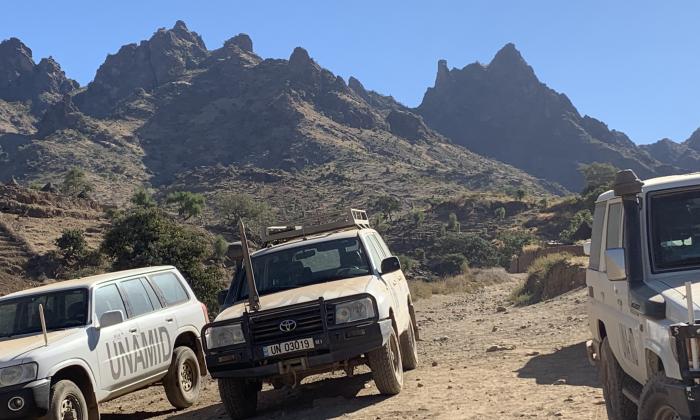Equipping peacekeepers with the structures, policies, and personnel to support technology
Supporting the implementation of mandated tasks through digital technologies | Lauren SpinkUN peace operations need to employ new technologies to enhance their ability to implement their mandates more effectively in the complex conflict contexts where they are currently deployed and to adapt to changing conflict dynamics in the future. Of the 13 UN peacekeeping missions authorized today, seven of them are explicitly mandated to protect civilians and these seven missions are the largest, comprising 95% of all deployed peacekeepers. For these missions situational awareness is key to understanding and combatting protection threats and therefore to achieving their mandated tasks, in particular keeping pace with perpetrators of violence as they shift their capabilities and tactics for committing violence against civilians. Relatively modest improvements in the technological capabilities of missions could have a large impact on situational awareness, such as putting smart phones in the hands of the staff managing early-warning systems and deploying newer generation drones to improve imagery.
However, UN peacekeeping missions face a number of barriers when it comes to introducing new technologies. These technologies won’t be fully effective in improving peacekeeper performance if missions don’t have the right structures, policies, and personnel to manage them. This blog highlights four issues that UN Member States and the UN Secretariat need to tackle to build a foundation for the effective adoption of new technologies.
Data Management
Maintaining situational awareness is achieved through an information and intelligence cycle that includes collecting information about a threat environment, analyzing that information, disseminating analysis to key personnel, and using analysis as the basis for planning and decision-making. The foundation of the cycle is information collection. But, most peacekeepers do not complain about a lack of information, they complain about having too much information on threats that is not properly managed or utilized. Missions need to improve and streamline their information-sharing and data management systems.
What is missing to ensure missions fully utilize the information systems they have in place are policies and oversight by leadership that promote strong data management.
Missions already have most of the technology to resolve this problem, such as COSMOS—a common file storage and sharing cloud and SAGE—a centralized incident-tracking and analysis database that can be packaged together with other mapping and network visualization tools under the Unite Aware platform. What is missing to ensure missions fully utilize the information systems they have in place are policies and oversight by leadership that promote strong data management. For example, missions are supposed to develop mission-wide information acquisition plans that outline for staff what information should be prioritized during collection efforts and how this information is then shared to ensure staff have access to it at appropriate times for analysis and decision-making. But these plans are often not in place.
Although SAGE has been deployed to most UN peacekeeping missions, personnel in many missions continue to maintain parallel spreadsheets and incident-tracking systems rather than fully utilizing a single, centralized database. And in spite of COSMOS, staff turnover often strips missions of vital expertise and institutional memory because gaps between deployments leave them without proper hand-overs. Staff are sometimes unaware of vital policies and directives until months into their deployments because files are disorganized or not shared with them as part of their orientation.
Integrated Planning
The strength of peacekeeping missions is that they are multi-dimensional—with civilian, military, and police personnel deployed under one mandate and structure. However, to make full use of the personnel and technological capabilities that missions do have, they need integrated planning. The UN Multidimensional Integrated Stabilization Mission in Mali (MINUSMA) has unmanned aerial vehicles (UAVs) at its disposal but before MINUSMA strengthened its integrated planning, these UAVs were primarily being used by the military component, for military purposes, such as self-protection for patrols. However, in recent years the Mission has brought civilian, police, and military planners together under its Strategic Planning Unit (SPU) and reinforced the capacity of the unit by hiring additional civilian staff. Now, UAVS are more regularly utilized to meet the information needs of all mission components and to analyze threats against civilians. Other peacekeeping missions are still operating with only two strategic planners who face a Herculean set of tasks that can prevent them from serving a true integrated planning role.
Human resources
Relatively small adjustments in the staffing of peacekeeping missions could improve the ability of missions to protect civilians as much, or more than, any technological upgrades and technology needs to be in the hands of the right personnel to be used appropriately. The UN’s human resources system, while designed to deter corruption, makes it extremely difficult for missions to hire personnel with the specific skillsets and context-knowledge needed for strong analysis. Inflexible contracts and strong unions also make it difficult for missions to dismiss underperforming or negligent staff. Some gaps in expertise can be filled more flexibly through short-term or consultant positions. But, tighter peacekeeping budgets over the last several years have made it difficult for missions to get funding for these posts and other full-term staff positions intended to support situational awareness, such as field-based analyst and coordinator posts. One MONUSCO official in Goma likened this web of human resource constraints to being “asked to fix the problem with two hands tied behind our backs.”
Troops deployed in high-threat environments sometimes lack fundamental skills to maintain situational awareness and perform their roles.
There is also a need for increased transparency in how troops are selected for deployment to missions. Troops deployed in high-threat environments sometimes lack fundamental skills to maintain situational awareness and perform their roles. The most blatant example of this is when troops without French language skills are deployed to French-speaking countries and then struggle to engage the civilian population with the limited number of language assistants available to them in-mission. Moreover, military officials deployed to serve in the U2 branch of the Force—responsible for intelligence—sometimes have very little background and training in intelligence acquisition or information analysis.
Accountability
To ensure that technology fosters improved performance, missions also need better accountability systems that measure impact rather than tracking intermediate factors. Troop contributing countries (TCCs) sometimes deploy their personnel without the basic technology—like night-vision goggles and communications equipment—needed for them to maintain situational awareness or deploy them with equipment that is unusable. Missions have processes in place for tracking whether troops deploy with the equipment that they are contracted to bring and whether that equipment is serviceable. But while tracking this information can ensure TCCs are not paid for equipment that is damaged, it does little to aid a mission on the ground unless these statistics are used in decisions on future troop deployments. These systems also fail to measure whether personnel use these capabilities effectively and can create perverse incentives. One peacekeeper gave the example of troops not using night-vision goggles or UAVs to avoid the costly wear-and-tear and replacement that regular use would require. “They are prepared to not use the equipment [even] when it is equipment that could aid in protection of their own troops,” he said. Such systems reward troops who keep their equipment unused, in boxes and penalize those troops who are proactive and committed to protection of civilians.
Technology and better data analysis can help missions measure their impact and improve accountability. A number of experts have pointed to the possibility of using GPS to track patrols. GPS data could help ensure patrols are responsive to early warning alerts as well as arm forward-leaning commanders with better data for understanding the impact of patrols and adjusting patrol plans to make them more effective. Many missions have also begun implementing the UN Comprehensive Performance Assessment System (CPAS) that aims to better assess mission impact and feed information on impact into planning processes. But whether these tools are implemented and get traction depends on political buy-in and support for accountability from mission leadership and the leadership of UN agencies in New York and Geneva.
Equipping peacekeepers for the future
Many of these challenges and recommendations for improving the adoption of technology are not new. They are documented in reports by the Center for Civilians in Conflict (CIVIC) and other organizations or independent review teams carrying out research on peace operations. They are reflected in the Secretary-General’s Action for Peacekeeping initiative, launched in 2018, and the subsequent Declaration of Shared Commitments, endorsed by over 150 Member States and four regional organizations. But while many of these points are not new, they have not been adequately addressed by UN reforms, and they will undermine the impact any new technology has on the situational awareness of missions and their ability to successfully implement their mandates, including protection of civilians. Equipping missions for the future of peacekeeping should include more than discussing new technology. It has to include Member States and the UN headquarters implementing their commitments: to provide adequate resources for missions; to deploy appropriately trained and equipped personnel; and to hold all personnel accountable for their performance. It also has to include mission leadership recognizing the vital role that they play in supporting situational awareness and putting in place the policies and processes that lead to good data collection, data management, and data-driven decision-making.
Download article
Images
- Author | Lauren Spink priv.
- UNAMID | Thomas Mandrup

